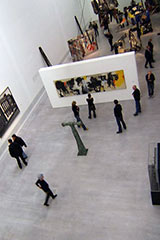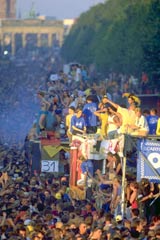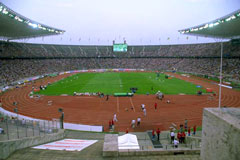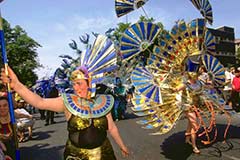
Berlin - City of Culture
Full programme
Berlin is a city where nothing stands still for long, and, over the last few years, the city has become a magnet for a new breed of young, contemporary artists, whose influence has been felt nationwide. The Hamburger train station, a monument to industry, has been converted into the Museum für Gegenwart, a temple of modern art.
At the same time, Berlin's Mitte and Prenzlauer Berg have become home to a modern gallery scene which often provokes international interest. Sandwiched between the River Spree and the Kupfergraben is the world famous Museum Island, whose buildings house architectural and artistic treasures from major 19th century collections. Berlin's many museums are a repository of art, science, and history, and create a distinct cultural landscape.
 The numbers are staggering: Berlin has three opera houses, over 1500 theatres and stages, more than 175 museums and collections, roughly 300 galleries, in excess of 250 public libraries, 130 cinemas and a multitude of other cultural possibilities.
The numbers are staggering: Berlin has three opera houses, over 1500 theatres and stages, more than 175 museums and collections, roughly 300 galleries, in excess of 250 public libraries, 130 cinemas and a multitude of other cultural possibilities.
It should be no surprise that every day in Berlin there are up to 1500 exhibitions awaiting you, offering a unique spectrum from classical fine art to a lively, underground artistic scene. With an annual cultural budget of almost one billion euros per year, Berlin is a world leader when it comes to culture.
As early as the 1920s, magazines and newspapers had dubbed Berlin the “City of music and theatre“. With Germany's largest selection of theatres and orchestras, Berlin has everything to satisfy even the greatest cultural appetite: from Boulevard to classical opera, from music-hall theatre to revué, and from varieté in the Wintergarten to cabaret, everything is catered for.
Carnivals of culture and parades
In contrast to Cologne, Düsseldorf, and Mainz, Berlin is not really a carnival city, at least not in the conventional sense. Even so, in early summer every year Berlin puts on a show to rival all others, the annual Karneval der Kulturen.
The Karneval der Kulturen developed as a result of Berlin's increasingly multicultural identity. As the city with the highest number of foreigners in Germany (around 440,000), Berlin has taken on the role of melting-pot. The Werkstatt der Kulturen - the organising force behind the Karneval der Kulturen - was founded in Berlin-Neukölln in 1993, and sees Berlin as a place for dialogue and as a meeting ground for people from different cultural backgrounds, nationalities, and religions. This is the backdrop against which the Karneval der Kulturen came to life.
Berlin's Karneval der Kulturen belongs to the same family of modern European carnivals as Notting Hill in London and Rotterdam's Zomercarnaval, but given the wider range of nationalities represented it stands in a class of its own. Up to 1.5 million visitors descend on Berlin-Kreuzberg each year to marvel at the spectacle.
 Just as many people attended 1999's Love Parade. The techno parade, initiated by the DJ Dr Motte, became a magnet for ravers from all over Europe and the world, but was overtaken by Zurich's Streetparade in 2003. Because of problems over sponsorship there were no Love Parades in 2004 and 2005, and no-one is sure at the moment where, when, or even if, there will ever be another love Parade in Berlin. Only its organisers, the Loveparade GmbH can say for sure, but they'll have to find a way to deal with the mountains of rubbish and the trampled Tiergarten, which are the negative side of such a massive parade.
Just as many people attended 1999's Love Parade. The techno parade, initiated by the DJ Dr Motte, became a magnet for ravers from all over Europe and the world, but was overtaken by Zurich's Streetparade in 2003. Because of problems over sponsorship there were no Love Parades in 2004 and 2005, and no-one is sure at the moment where, when, or even if, there will ever be another love Parade in Berlin. Only its organisers, the Loveparade GmbH can say for sure, but they'll have to find a way to deal with the mountains of rubbish and the trampled Tiergarten, which are the negative side of such a massive parade.
Another member of the carnival and parade family is Christopher Street Day, which started in Berlin in 1979. CSD is a fixed highlight of the parade calendar and takes place at the end of June each year. Although Cologne has its nose slightly in front with 1.2 million visitors, that shouldn't do any harm to Berlin's reputation as Europe's Queer Capital.
Celebrities and famous people are always in attendance, and Bundestag President Thierse was there in 2000, and naturally Berlin's openly-gay mayor, Klaus Wowereit, makes a point of being there. From its origins as a political demonstration by a brave couple of hundred protesters, CSD has developed into a highly commercialised spectacle with up to one million visitors. A bottle of Sekt (sparkling wine) is still obligatory for many.
Berlin for sports fans
Berlin has an amazing number of fitness centres and sports clubs, although most Berliners take part in mass sports. There are also a few professional sports clubs, amongst which are Hertha BSC Berlin and 1. FC Union Berlin playing soccer in the first and second divisions of German soccer respectively, the Eisbären (German ice hockey champions once again in 2006), Alba (German basketball champions again in 2006) and the American Football team, Berlin Thunder. In the German volleyball league, Berlin is represented by three teams.
 Approximately 40,000 runners take part in the annual Berlin Marathon. The German football cup final and the ISTAF athletic championships also take place in Berlin annually. As part of Berlin's application for the summer Olympics in 2000, which were eventually awarded to Sydney, most of Berlin's stadia, sports centres, and playing fields were renovated and many new sites were developed, such as the Max-Schmeling-Halle and the SSE Europa Sportpark with its two full-size swimming pools. The final of the 2006 Football World Cup took place in Berlin, for which the Olympic Stadium has been completely refurbished. In 2009 the World Athletics championships are heading to Berlin.
Approximately 40,000 runners take part in the annual Berlin Marathon. The German football cup final and the ISTAF athletic championships also take place in Berlin annually. As part of Berlin's application for the summer Olympics in 2000, which were eventually awarded to Sydney, most of Berlin's stadia, sports centres, and playing fields were renovated and many new sites were developed, such as the Max-Schmeling-Halle and the SSE Europa Sportpark with its two full-size swimming pools. The final of the 2006 Football World Cup took place in Berlin, for which the Olympic Stadium has been completely refurbished. In 2009 the World Athletics championships are heading to Berlin.
ALPADIA Berlin • D-10827 Berlin • Hauptstraße 23/24
+49 30 7811076 • • City Map & Route Planner

